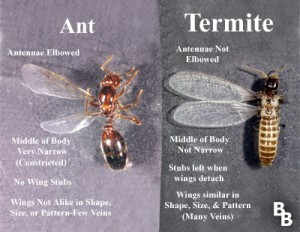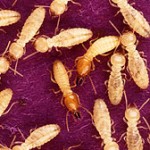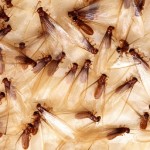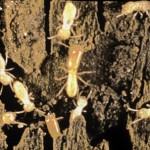San Antonio Express News
GARDENING, Etc.
Sunday, April 10, 2005
By Molly Keck
Spring is heating up and termite swarming season is now upon us.
Because a home is usually the largest investment a person makes, protecting it from damage very important. Termites are the most destructive wood damaging insects and cause billions of dollars in damage yearly. Although they are extremely detrimental to humans, they are also very valuable. They decompose waste products and provide the atmosphere with nitrogen which is necessary for our existence.
It is about that time of year when certain types of insects are performing their mating flights, or “swarming.” Termites are one of those types of insects. However, just because you see a winged insect flying around your home does not necessarily mean they are termites. Ants also swarm and are often mistaken for termites. Here are some tips to help you determine if the swarmers are actually termites or ants.
 Ants have two pairs of wings, but the hind pair is shorter in length than the front pair. If the wings have fallen off (as they commonly do) look at the body of the insect: ants have a narrowed “waist” close to the middle of their body. Ants also have elbowed or bent antennae. Termites have two pairs of wings as well, but they are equal in length. Their bodies do not have a narrowed waist and their antennae are not elbowed. If you are still not sure whether you have termites or ants, mail or drop a sample by the Bexar County Extension office. Remember to provide more than one specimen and include as many wings you can. Also, use a container so the insects are not damaged in transit and make sure they are dead before you transport them. If you know you have termites it is a good idea to have a professional determine the species of termite so that you can get the best treatment possible.
Ants have two pairs of wings, but the hind pair is shorter in length than the front pair. If the wings have fallen off (as they commonly do) look at the body of the insect: ants have a narrowed “waist” close to the middle of their body. Ants also have elbowed or bent antennae. Termites have two pairs of wings as well, but they are equal in length. Their bodies do not have a narrowed waist and their antennae are not elbowed. If you are still not sure whether you have termites or ants, mail or drop a sample by the Bexar County Extension office. Remember to provide more than one specimen and include as many wings you can. Also, use a container so the insects are not damaged in transit and make sure they are dead before you transport them. If you know you have termites it is a good idea to have a professional determine the species of termite so that you can get the best treatment possible.
The most common type of termite found in San Antonio homes is the native subterranean termite. However, recently Formosan termites have been discovered in Bexar County. These termites are originally from Central America and the Far East and were brought to the U.S. in infested wood. Humans are currently helping Formosan termites spread by using railroad ties and other infested wood items for landscaping. It would be extremely wise to rethink using old railroad ties and shoring timbers in your gardens and yards because it is very likely you will introduce termites.
- Formosan Subterranean Termites Photo: USDA-Scott Bauer
- Formosan Termite Alates (or Swarmers) Photo: insectimages.org
- Winged Subterranean Reproductive Termite Photo: TAMU-J. Hamer
Researchers at Texas A&M University are concerned about the spread of Formosan termites because they are extremely aggressive wood eaters, and until humans understand how they are spreading them, it is likely they can become established throughout Texas.
Unlike native subterranean termites, if a colony is separated from the nest (or queen) they can still survive and continue to eat wood. They also spread very rapidly as they make new nests and find new areas to feed.
There are several ways to indicate that you may have termites. One is the presence of swarmers or their wings in and around window sills. Swarming usually occurs in the evenings because they are attracted to lights, so look around your porch lights for dead swarmers or wings. Another sign is the presence of mud tubes around the foundation of the structure, leading into the home. Mud tubes are made by the termite workers to provide protection as they move in and out of the structure. Damaged wood is another sign that you may have termites. If you notice any of these things call a pest control operator to inspect your home.
- Termites working trails in wood. Photo courtesy of UMN University Extension
- Subterranean Termite Workers Photo courtesy of PSU Extension
If you would like more information on termites send a self addressed, stamped envelope to Texas Cooperative Extension- Termites, 3355 Cherry Ridge Suite 212, San Antonio, TX 78230 or call (210)467-6575. If you have internet access, you can also visit http://termites.tamu.edu. and http://insects.tamu.edu/fieldguide/aimg26.html.
Next week we will explore the different options you have for termite treatment as well as preventative measures you can take to protect your home.
This article was written by Molly Keck, Integrated Pest Management Program Specialist with Texas Cooperative Extension in Bexar County.




